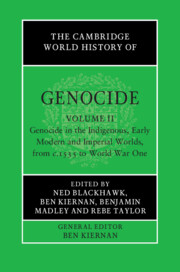Book contents
- The Cambridge World History of Genocide
- The Cambridge World History of Genocide
- The Cambridge World History of Genocide
- Copyright page
- Contents
- Figures
- Maps
- Tables
- Contributors to Volume ii
- Introduction to Volume ii
- Part I Settler Colonialism
- Part II Empire-Building and State Domination
- Part III Nineteenth-Century Frontier Genocides
- 15 The Genocidal French Conquest of Algeria, 1830–1847
- 16 ‘The Bloody Ground’
- 17 ‘A War of Extermination’
- 18 Lessons from Canada
- 19 Frontier Massacres in Australia, 1788–1928
- 20 Genocide in Van Diemen’s Land (Tasmania), 1803–1871
- 21 Genocide in Northern Australia, 1824–1928
- Part IV Premonitions
- Index
17 - ‘A War of Extermination’
The California Indian Genocide, 1846–1873
from Part III - Nineteenth-Century Frontier Genocides
Published online by Cambridge University Press: 23 June 2023
- The Cambridge World History of Genocide
- The Cambridge World History of Genocide
- The Cambridge World History of Genocide
- Copyright page
- Contents
- Figures
- Maps
- Tables
- Contributors to Volume ii
- Introduction to Volume ii
- Part I Settler Colonialism
- Part II Empire-Building and State Domination
- Part III Nineteenth-Century Frontier Genocides
- 15 The Genocidal French Conquest of Algeria, 1830–1847
- 16 ‘The Bloody Ground’
- 17 ‘A War of Extermination’
- 18 Lessons from Canada
- 19 Frontier Massacres in Australia, 1788–1928
- 20 Genocide in Van Diemen’s Land (Tasmania), 1803–1871
- 21 Genocide in Northern Australia, 1824–1928
- Part IV Premonitions
- Index
Summary
On 18 June 2019, California’s Gavin Newsom became the first governor in United States history to apologise publicly for a genocide committed in their state. Shaded by a grove of trees at the site of West Sacramento’s future California Indian Heritage Center, Newsom stood in a circle with tribal leaders. After recounting evidence of state-sponsored mass murder, Governor Newsom insisted: ‘It’s called a genocide. That’s what it was: a genocide, no other way to describe it. And, that’s the way it needs to be described in the history books.’ Finally, the governor of the most populous and prosperous state in the wealthiest nation in the world publicly apologised: ‘I’m sorry on behalf of the state of California.’1 Genocide was a formative event in the making of the state. Yet relatively few people, even in California, know this history.
- Type
- Chapter
- Information
- The Cambridge World History of Genocide , pp. 412 - 433Publisher: Cambridge University PressPrint publication year: 2023



